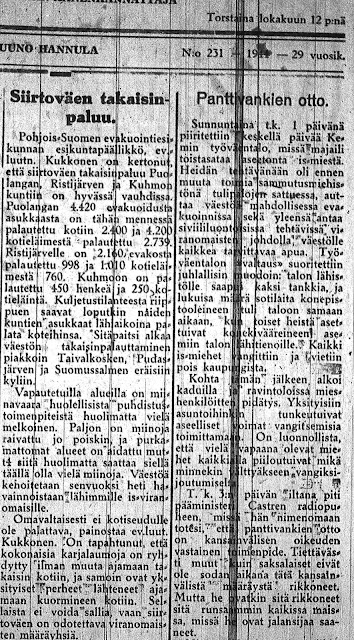
The last German troops were expelled in April 1945. By that time only 600 Finnish troops, mostly fresh recruits, were left facing them due to the Soviet demand for demobilisation of the Finnish army. Because of this, the latter half of the Lapland War is known in Finland as the Children's Crusade. In their retreat the German forces under General Lothar Rendulic devastated large areas of northern Finland using scorched earth tactics. Total of 40–47 % the dwellings in the area were destroyed, and the provincial capital of Rovaniemi was burned to the ground, as well as Savukoski village. Two thirds of the buildings in main villages Sodankylä, Muonio, Kolari, Salla and Ivalo were demolished. 675 bridges were blown up and all main roads were mined, 3,700 km of telephone lines were destroyed. In addition to the property losses, estimated as equivalent to about US $300 million (in 1945 dollars, which is equivalent to $3.15 billion in 2005 dollars), about 100,000 inhabitants became refugees, a situation that added to the problems of postwar reconstruction. (After the war the Allies convicted Rendulic of war crimes, and he was sentenced to 20 years in prison. He was released after six years.) Wikipedia
Before the Lapland war began there were 100,000 finnish children in Sweden and lot of people from other countries. The Swedish authorities approved the Finns call for an evacuee, from Lapland should perhaps 100,000 people, and perhaps the same number of cows and other animals. Sweden was ready to receive evacuees already 15.9.1944, Swedes made empty army huts for the purpose. The departure was delayed badly, when the Finnish troops suddenly made landings to Röyttä 1.10. Evacuation was given command for the people of Alatornio 4.10. Population and livestock was moved to Sweden. During the war over 56,000 people went to Sweden and 47,500 to southern Finland. Lapland's population at that time was 144,000. Children went to school and in for sports. The Swedish postal officials collected the money for the skies and sledges of Finnish children.

Salmon was about three and a half when war started in September 1944. We had to go Sweden before finnish troops came to Tornio, but we were late. We were evacuated to Karsikkojärvi some days after the war begun. War ended 27th, April, all german soldiers pushed by violance to Norway. Long time after the war there were lot of mines and other dangerous ammunition offered especially for small boys everywhere. Fortunately nothing happened to salmonboy.
Cows were taken to Sweden more than 30,000, horses a couple of thousand, as well as sheep and pigs for more than one thousand. The surface of the border farther to Swede
 n the cows were forced to stay first to Haparanda under the open sky, mud and rain and cold of course, after they were walked hundreds of kilometers of their home country. Cattle evacuee had minders, but the horses were with their owners, shoeing and cows' milking were also arranged. The Finns had to keep their animals carefully separated the Swedes' cattle already in the disease because of the risk. To Finland's Central Ostrobothnia were evacuated 20,000 cows and more than 4,000 horses.
n the cows were forced to stay first to Haparanda under the open sky, mud and rain and cold of course, after they were walked hundreds of kilometers of their home country. Cattle evacuee had minders, but the horses were with their owners, shoeing and cows' milking were also arranged. The Finns had to keep their animals carefully separated the Swedes' cattle already in the disease because of the risk. To Finland's Central Ostrobothnia were evacuated 20,000 cows and more than 4,000 horses.Pohjolan Sanomat newspaper told every day what happened during these fights. Paper was published in the middle of the war. During the most severe days paper had to change the size of pages smaller that little paper was delivered from 3rd to 16th of October. The war started in September 1944.
Pohjolan Sanomat 3rd, September 1944:
Finland's Parliament asked
German troops leave Finland.
The truce with Sovjet Union started
Finland cut relationships with Germans
All things what Germans leave
belongs Finnish Army
Finland's Army commander-in-chief,
marshal Mannerheim tells situation
Negotiations with russians
on the frontier
Heavy truce in Moscow:
Carelia, Petsamo and Porkkala lost to Sowiet Union
and 300 hundred billion dollars war indemnities
All people and domestic animals,
even reindeers evacuated:
50% to Sweden and
50% to more south of Finland,
reindeers to Sweden
The text of peace treaty was published
Control comission for peace treaty
Marshal Mannerheim's order of the day
Finnish troops started to fight agaist germans
Haukipudas and Puolanka occupied
more than 20.000 people and
more than 8.000 cows and horses
taken to Sweden via Haparanda
Pohjolan Sanomat telling every day
about germans' destructions
Picture of the signing situation
of the peace treaty in Moscow
Picture from the bridge between Finland
and Sweden, cows going to safety away from the war
4000 reindeers taken to Sweden from Enontekiö
Tough fights in Tornio with germans after
finnish troops came by ships from Oulu to Tornio
5.10.1944 germans fighted twice back in Tornio
but finnish troops repeled both
Kemi is free from germans
Kemi is hometown for Pohjolan Sanomat
The german troops seized altogether
about 200 as hostage
Paper telling that finnish attack night and day
Ylitornio occupied by finnish troops
The town hall of Kemi tried
to blow up by germans
Rovaniemi occupied
Pello burnig
Swedish journalist took picture
when Tornio was burning
Rovaniemi in ruins
Kittilä occupied
Northern part of Lapland occupied
Enontekiö in ruins
Germans in Lätäseno
Finnish evacuated are in 300 camps in Sweden
LAPIN KANSA - NEWSPAPER
IN ROVANIEMI
Paper was not published in about a month (4th, Sep - 12th Oct)
Lapin Sota I
Lapin Sota II
Lapin Sota III
Lapin Sota IV
Lapin Sota ruotsiksi, Laplands Krig på svenska (Yle)
Lapin sota alkoi Torniossa, kuvattu Haparandasta:
'























































